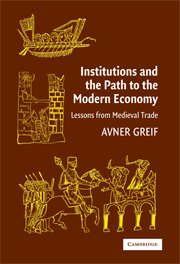Book contents
- Frontmatter
- Contents
- Abbreviations
- Preface
- I Preliminaries
- II Institutions as Systems in Equilibria
- III Institutional Dynamics as a Historical Process
- 6 A Theory of Endogenous Institutional Change
- 7 Institutional Trajectories: How Past Institutions Affect Current Ones
- 8 Building a State: Genoa's Rise and Fall
- 9 On the Origin of Distinct Institutional Trajectories: Cultural Beliefs and the Organization of Society
- IV The Empirical Method of Comparative and Historical Institutional Analysis
- V Concluding Comments
- Appendixes
- References
- Index
- POLITICAL ECONOMY OF INSTITUTIONS AND DECISIONS
7 - Institutional Trajectories: How Past Institutions Affect Current Ones
Published online by Cambridge University Press: 05 September 2012
- Frontmatter
- Contents
- Abbreviations
- Preface
- I Preliminaries
- II Institutions as Systems in Equilibria
- III Institutional Dynamics as a Historical Process
- 6 A Theory of Endogenous Institutional Change
- 7 Institutional Trajectories: How Past Institutions Affect Current Ones
- 8 Building a State: Genoa's Rise and Fall
- 9 On the Origin of Distinct Institutional Trajectories: Cultural Beliefs and the Organization of Society
- IV The Empirical Method of Comparative and Historical Institutional Analysis
- V Concluding Comments
- Appendixes
- References
- Index
- POLITICAL ECONOMY OF INSTITUTIONS AND DECISIONS
Summary
Societies face new situations when an institution that governed a transaction is no longer self-enforcing, when it is perceived to be losing its self-enforcing characteristics, or when technological, organizational, and other changes bring about new transactions. Do past institutions – perhaps even institutions that are no longer effective in influencing behavior – affect the direction of institutional change? If they do, why and how?
The intentionally created perspective on institutions, which often views them as rules, emphasizes that new institutions reflect the interests and inductive reasoning of economic or political agents. Evolutionary institutionalism emphasizes the importance of environmental – structural – forces and the lack of deductive reasoning. To explain the impact of past institutions, these perspectives commonly invoke as exogenous one set of institutions to explain subsequent ones. In studying economic institutions as rules, for example, it is common to study the formation of the rules while considering either political or informal – culturally determined – institutions as given. This position, however, amounts to pushing the question of institutional impact one step back.
In contrast, this chapter explores why and how the past, encapsulated in institutional elements, directs institutional change and leads societies to evolve along distinct institutional trajectories. Exploring the properties of the social elements that make up an institution is the central focus of this argument. These properties imply a fundamental asymmetry between institutional elements inherited from the past and technologically feasible alternatives.
- Type
- Chapter
- Information
- Institutions and the Path to the Modern EconomyLessons from Medieval Trade, pp. 187 - 216Publisher: Cambridge University PressPrint publication year: 2006
- 1
- Cited by



